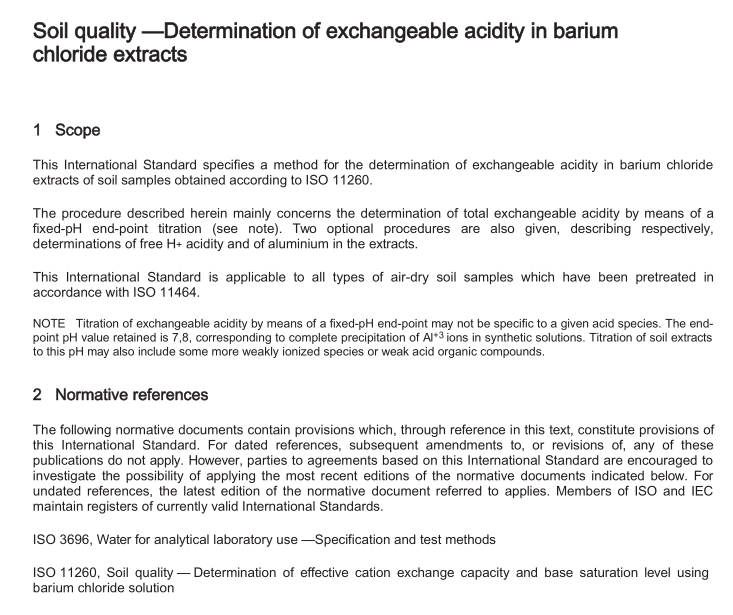BS EN ISO 14254 pdf download

BS EN ISO 14254 pdf download Soil quality — Determination of exchangeable acidity in barium chloride extracts (ISO 14254:2001)
This International Standard specifies a method for the determination of exchangeable acidity in barium chlorideextracts of soil samples obtained according to lSO 11260.
The procedure described herein mainly concerns the determination of total exchangeable acidity by means of afixed-pH end-point titration (see note). Two optional procedures are also given,describing respectively,determinations of free H+ acidity and of aluminium in the extracts.
This International Standard is applicable to all types of air-dry soil samples which have been pretreated inaccordance with ISO 11464.
NOTE Titration of exchangeable acidity by means of a fixed-pH end-point may not be specific to a given acid species. The end-point pH value retained is 7,8,corresponding to complete precipitation of A*3 ions in synthetic solutions. Tiration of soil extractsto this pH may also include some more weakly ionized species or weak acid organic compounds.
2Normative references
The following normative documents contain provisions which, through reference in this text, constitute provisions ofthis International Standard.For dated references, subsequent amendments to, or revisions of, any of thesepublications do not apply. However,parties to agreements based on this International Standard are encouraged toinvestigate the possibility of applying the most recent editions of the normative documents indicated below.Forundated references, the latest edition of the normative document referred to applies. Members of lS0 and IECmaintain registers of currently valid lnternational Standards.
ISo 3696, Water for analytical laboratory use—Specification and test methods
ISO 11260,Soil quality —Determination of effective cation exchange capacity and base saturation level usingbarium chloride solution
ISO 11464,Soil quality —Pretreatment of samples for physico-chemical analyses
IS0 11465,Soil quality —Determination of dry matter and water content on a mass basis —Gravimetric method
3Principle
The soil sample is extracted in accordance with lSO 11260.The
extract is titrated with a
0,1 mol·l-1
0,05 mol- l-1
NaOH solution up to pH=7,8.The use of phenolphthalein as indicator is allowed, but shall be specified in the testreport.
An alternative method for determination of the free H+ acidity is proposed, in which sodium fluoride is added to thesoil extract before the titration(BaF2 precipitates but an excess of NaF is not necessary). Aluminium ions arecomplexed and only the H+ acidity is detected during the titration process.
Two other optional methods for the determination of aluminium are proposed,using respectively flame atomicabsorption spectrometry and inductively coupled plasma emission spectrometry.
5 Apparatus
5.1 Usual laboratory glassware, including a burette graduated in intervals of 0,05 ml or smaller.5.2pH-meter
Set up following the manufacturer’s instructions and calibrate with buffer solutions (4.3).5.3Magnetic stirrer
5.4Automatic titrimeter (optional)
Set up following the manufacturers instructions and calibrate with buffer solutions (4.3).Results shall be expressedrelatively to an end-point of pH = 7,8.
5.5Flame atomic absorption spectrometer
Equip with a nitrous oxidelacetylene burner and set up following the manufacturer’s instructions. Determination ofaluminium is commonly carried out at a wavelength of 396,2 nm.
5.6Inductively coupled plasma spectrometer
Set up following the manufacturers instructions.Determination of aluminium is commonly carried out withbackground correction at various wavelengths such as 309,28 nm or 396,15 nm.
6 Sample
6.1 Barium chloride extract, obtained in accordance with ISO 11260.6.2 Blank extract, obtained in the same way.
7Procedure
7.1 Total exchangeable acidity
Pipette 50 ml of the extract (6.1) into a container of sufficient capacity to also receive the electrodes of the pH-meter(5.2). Introduce a bar magnet and set up the speed of the magnetic strrer (5.3).Insert the electrodes and tirate withthe sodium hydroxide solution (4.7) until a pH value of 7,8 is reached and remains stable for 30 s.
When phenolphthalein is used, titrate until the colour just turns permanently pink (in practice wait about 30 s). Titrate50 ml of the blank solution (6.2) in the same way in order to obtain a blank value.
7.2 Free Ht acidity (optional)
Pipette 50 ml of the extract (6.1).Add 2,5 ml of the sodium fluoride solution (4.8). Titrate with the sodium hydroxidesolution (4.7) to a pH value of 7,8.
When phenolphthalein is used,titrate until the colour just turns permanently pink (in practice wait about 30 s).Titrate a blank (6.2) in the same way.
NOTE The total volume extracted in accordance with lS0 11260 is 100 ml. f determinations of exchangeable cations, totalacidity and free He acidity are needed, volumes pipetted in 7.1 and 7.2 need to be adapted.
7.3 Spectrometric determination of aluminium (optional)
For both proposed spectrometric methods, the calibration curves are practically linear for the standard solutions(4.13).Samples (6.1) with aluminium concentrations exceeding the range of calibration need to be diluted withextracting solution prepared according to ISO 11260.
Contamination by aluminium is unusual and easily avoided, so differences between the signals given by thecalibration blank and by the extraction blank should not be accepted.









